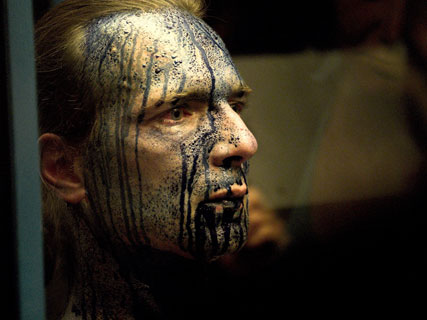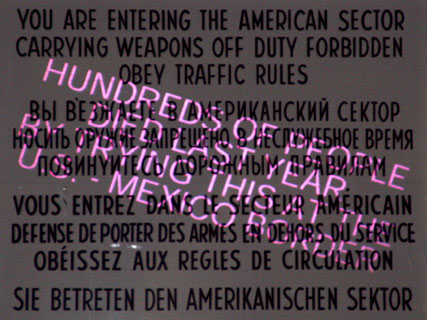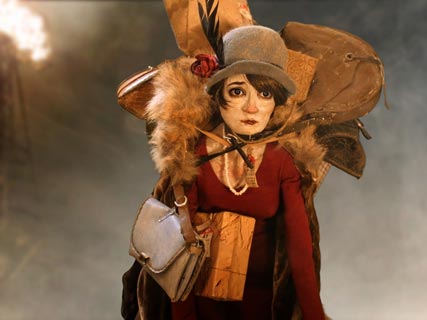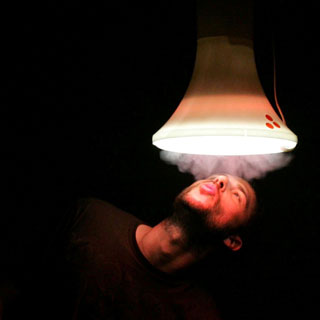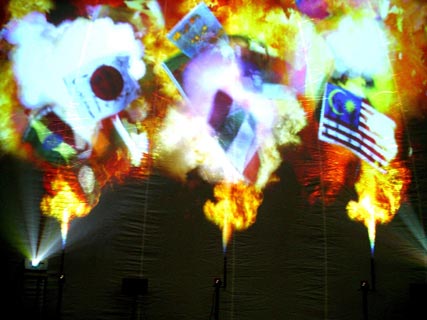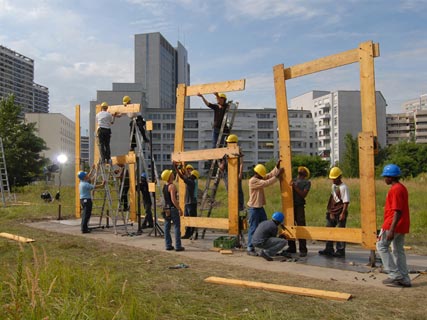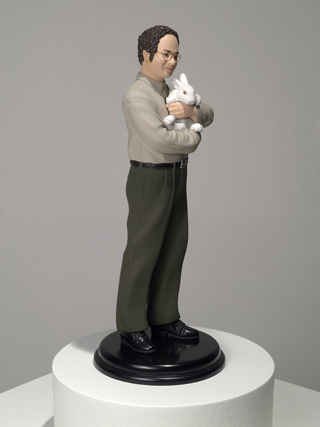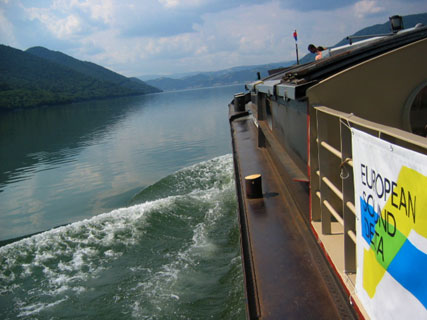The Linz “Art, Technology and Society” festival has over the years become the main back-from-summer rendezvous for a good number of artists, research scientists, curators and critics. The theme for 2008: A new cultural economy - The limits of intellectual property.
 G
Gerfried Stocker and Christine Schöpf tell us that the “the age of copyright and intellectual property has reached its expiration date”. So Joichi Ito, the general director of the Creative Commons proposing alternatives to Copyright, was chosen by the two artistic directors of the
Ars Electronica festival and given the responsibility of leading the symposium devoted to the necessity of building a new cultural economy together in the digital and network age. And this issue arrives exactly at the right time, as Linz will be the European capital for culture in 2009.
Evelina Domnitch
& Dmitry Gelfand,
“Ten Thousand Peacock
Feathers in Foaming Acid”,
2007.
 Between art and science
Between art and science
 O
Openings follow one after the other on this Thursday in September that inevitably ends in an evening opening that takes place in the hills of Linz. Several performances are given at the same time such as one called “Ten Thousand Peacock Feathers in Foaming Acid” conceived by
Evelina Domnitch and
Dmitry Gelfand. These two are known to festival goers for having been awarded an honorary mention last year for their installation “Camera Lucida” that works around a phenomenon called sono-luminescence. During the performance, Evelina Domnitch generates and manipulates soap bubbles through which a white light laser passes. A multitude of red, green and blue filaments come to life before disappearing for ever and we then understand the meaning of the title promising us thousands of peacock feathers. Dmitry Gelfand converts this visual universe, which is not unlike the prepared television screens of Nam June Paik, into sounds participating in a sound environment that is in complete symbiosis with the projected images. Randomness, which was much appreciated by the members of the Fluxus movement, is essential in this magnification of soap bubbles that perfectly illustrates these two artists’ interest in ephemeral manifestations.
Yann Marussich,
“Bleu Remix”,
2007.
 T
Two days later, another performance takes place at the Lentos Museum where a cross between art and science is at play.
Yann Marussich has placed himself, almost naked as is the wont of body artists, in a glass cage and will stay there for an hour, emerging only after the public have left the scene. The artist met with doctors and chemists to conceive “Blue Remix”, which follows in line with another performance dating from 2001 entitled “Bleu Provisoire”. He remains entirely immobile throughout the performance. His breathing is slow and his regard almost vacant while secretions from his nose, ears and mouth, all coloured blue, drip slowly onto his skin, which little by little is covered by sweat of the same blue. “Everything is calculated”, Yann Marussich tells us before adding: “I become the subject of the experiment”. Confronted with this blue colour it is impossible not to think of Yves Klein’s Anthropometries. But here everything is slow and the choice of blue as a colour cancels any possible interpretation of blood flowing. Moreover, there is no colour more artificial, so rarely present in nature in either the animal or vegetable kingdoms, than this blue created by man and secreted by the artist.
Julius von Bismarck,
“Image Fulgurator”,
2007/2008.
 The Golden Nicas
The Golden Nicas
 T
There is no festival without prizes and one of the most highly sought after at Linz is the Golden Nica for Interactive Art, this year awarded to
Julius von Bismarck for his “Image Fulgurator”. It is an invention the Berlin artist hurried to patent before it fell into the hands of advertising agencies. It involves a camera that has been “modified” to trigger in reaction to light flashes from its immediate environment. But this camera, rather than taking pictures, projects them for only a few fractions of a second. These visuals are so furtive they remain undetectable to other photographers who discover them only when looking at the LCD screens of their own cameras. We can then understand why Julius von Bismarck especially favours political events and historical monuments where camera flashes constantly go off. And it’s in the crowd that the spectacle unfolds when one after the other of the photographers looks around, astonished and disconcerted, not knowing whether to believe in the reality around them or what they have captured in their cameras as being real. As for our activist, he transforms Obama into a preacher when he projects a cross on his pulpit in Berlin, or delivers a message of peace by superimposing a white dove, inspired by Magritte, onto the portrait of Mao in Beijing. The manipulation of real images is a practice that is inherent to photography. But here, it is not the images that are being modified but the reality, which undergoes a few imperceptible “modifications”.
Chris Lavis
& Maciek Szczerbowski,
“Madame Tutli-Putli”,
2007.
 E
Every digital art festival has a few animated film screenings like “Madame Tutli-Putli” by Chris Lavis & Maciek Szczerbowski. This is a short film produced by the
National Film Board of Canada and made in the purest tradition of film animation, frame by frame, with a slight difference in detail: Madame Tutli-Putli’s eyes have been borrowed from a real actress. And it is these few incrusted pixels that change everything by humanising the virtual actors of the film. The outcome of this hybridisation is startling.
 Smoke and flames
Smoke and flames
 A
A prize that awards Hybrid Art works was created last year and it is an entire project that is being awarded this year. The project is called Pollstream and was initiated in 2002 by the
HeHe collective based in Paris. Helen Evans and Heiko Hansen are both fascinated by clouds “as much by their movements as their undefined forms”, but it is nevertheless around man-made clouds that their research is focussed.
HeHe,
“Smoking Lamp”,
2005.
 “S
“Smoking Lamp”, from 2005, is nothing other than a lamp that crackles and sparkles whenever it detects cigarette smoke. So this highly participative sculpture needs to be installed in a room that is de facto transformed into a smoking area. Smoking has been accepted inside the OK Centrum, but how many other museums have refused this piece? Champs d’Ozone, made in 2007, is a “modified” window that allows visitors attending the exhibition “Airs de Paris” at the Pompidou Centre to visualise the quality of the capital’s air by changing colour based on the visual codes of “Airparif” whose detectors are located, among other places, in the Les Halles quarter. “Toy Emission”, produced the same year, is a performance during which two artists guide a miniature Porsche by remote control that gives off coloured smoke in the streets of Manhattan under the gaze of people passing by whose reactions are as immediate as they are varied. Lastly the HeHe collective have managed to produce a “Green Cloud” with the help of a laser beam that consists of “redesigning” the contours of a steam cloud coming from the impressive chimney of the Helsinki thermal power plant. The inhabitants of the neighbourhood saw this green cloud grow progressively bigger as they reduced their energy consumption in their homes during an operation called “Unplug”, which took place February 29th in 2008.
Du Zhenjun,
“Globe Fire”,
2007.
 I
It is not uncommon at Ars Electronica, for installations to only be presented via video documents, simply because they are often too voluminous. This is the case with “Globe Fire” by a Chinese artist living in France,
Du Zhenjun. It involves an eight metre high dome equipped with a dozen heat sensors with as many corresponding video image gas outlets that entirely cover this ephemeral architecture. The public is invited to transform them into as many virtual flames with the help of lighters that accompany them on the other side of the image. A multitude of flags then burst into flame, but it is imperative there be twelve participants for the fire to totally envelop the dome before an explosion gives way to smoke whose density might recall paintings by El Greco or representations of divine wrath in western painting. All that’s needed is everyone applying themselves together so that an event is generated that destroys all the flags of the world, which too often only catalyse hate and rancour. We should add that this installation also exists in a “politically correct” version without flags, which was exposed during the 2007 eArts Festival in Shanghai.
Standard Time,
“Mark Formanek
& Datenstrudel”,
2007.
 A Low Tech aesthetic
A Low Tech aesthetic
 A
A video work gives the time at the entrance to the OK Centrum and that is its only use. “Standard Time”, by Mark Formanek and
Datenstrudel, nevertheless mobilised the energies of seventy workers during the twenty-four hours that they manipulated, “in real time”, the wooden planks that made up the numbers of a digital clock. One might well ask oneself how much this performance that has been making the rounds of digital art festivals cost; constructing a “Low Tech” clock of wooden planks at a time when the price of a digital clock is only a few euros. But it is also interesting to note that digital here is nothing more than the subject of the representation that some will undoubtedly want to interpret as the end of the artistic practices associated with it.
Markus Kison,
“Touched Echo”,
2007/2008.
 O
On the mezzanine above “Standard Time”, there is a guardrail that enables the German artist
Markus Kison to place the public of the OK Centrum in the position of the spectators of the installation “Touched Echo” located in Dresden at this same moment. A pictogram incites us to cover our ears with our hands while resting our elbows on the guardrail. Two conditions are therefore necessary for listening, through our bones, to the sounds of plane engines similar to those that announced the terrible bombings of the city of Dresden at the end of WWII. Our position, similar to that of the spectators of Dresden, can only conjure that of the frightened inhabitants and refugees who could no longer stand the sound of the B-25s on these now historic days of February 13 and 14, 1945. Allied forces destroyed a third of the town without their motivations for doing so (which could only be described as relentless at a period when the war was coming to its end) ever really being made clear.
 An Off Ars?
An Off Ars?
 T
There are a few events every year that attach themselves to the festival without truly qualifying as “Off”. Just such a one was produced by the Danish gallery owner Peet Thomsen who decided to open a gallery temporarily this year on Marienstrasse. The Black Box Linz exhibited in particular a few works from
Eduardo Kac’s “Rabbit Remix” series, who in 1999 - well before the creation of the Golden Nica in Hybrid Art - set up a transgenic installation entitled “Genesis” at the OK Centrum.
Eduardo Kac,
“Featherless”,
2006.
 B
But it was only in 2000 that the project “GFP Bunny”, which the artist tells us “encompassed the creation of a fluorescent green rabbit, the public debate the project inspired and the rabbit’s social integration”, gave rise to the “Rabbit Remix” series. We can recall the rapidity with which the media of the time grabbed hold of this albino bunny that rays of blue light made luminescent following genetic modifications including the use of a fluorescent green protein coming from Aequorea Victoria jellyfish originating in the Pacific North West. “Alba”, the green bunny, though never really leaving the laboratories of the National Institute of Agronomic Research, has since been around the world in images. More fluorescent than ever, she is still very present on the Internet.
 A
As for Eduardo Kac, after having fought for animal liberation along with his friend Louis Bec, he continues to question the relationships that we sustain with the living by prolonging the “artificial” life of the GFP Bunny through a series of symbolic actions. Among them he has created two sculptures in 2006: the first is the three-dimensional representation of the only existing photograph of the artist holding the rabbit in his arms; the second looks like a Parisian street sign on which we read: Boulevard Alba - “Homage of France to the green bunny in recognition of her exceptional contribution to the defense of the rights of new living beings.”
“European Sound Delta”,
2008.
 W
We should lastly mention the barge the “Ange Gabriel” that is tied up a few steps from the Brucknerhaus where the Ars Electronica Gala takes place, which is part of a vast project called
European Sound Delta whose French co-organisers are members of the MU collective. The boat is travelling up the Danube to reach another “floating studio” in Strasbourg called “Le Gavroche” that is travelling along the Rhine. About thirty artists whose research focuses on sonic practices and radiophonic captures have embarked upon a program the length of their journey to give performances such as that in Linz during which Ewen Chardronnet, Aljosa Abrahamsberg, Horia Cosmin Samoïla and Joachim Montessuis control and broadcast sonic flux coming from a broad range of horizons. Frenchman Ewen Chardronnet’s imagination is very clearly inspired by the conquest of space while Aljosa Abrahamsberg from Slovenia intercepts every radio wave that comes within reach. The Romanian Horia Cosmin Samoïla scans the ionosphere with the help of a VLF (Very Low Frequency) antenna, while another Frenchman, Joachim Montessuis, literally sculpts the sounds and cries of his voice by energetically manipulating an instrument he developed in collaboration with the V2 Institute of Rotterdam.
 I
It is with projects such as these that a cultural Europe is slowly being built and the fact that the international renown of the Ars Electronica Festival has undeniably played a role in the choice of Linz as the capital of European culture for 2009, repositions the digital arts with respect to political issues that are today on a level with cities and states. Is the status of these emerging artistic practices that are too often ignored, in the process of evolving?
Written by Dominique Moulon for "Images Magazine" and translated by Geoffrey Finch for "newmediaart.eu", this article is also available in French on "nouveauxmedias.net".

